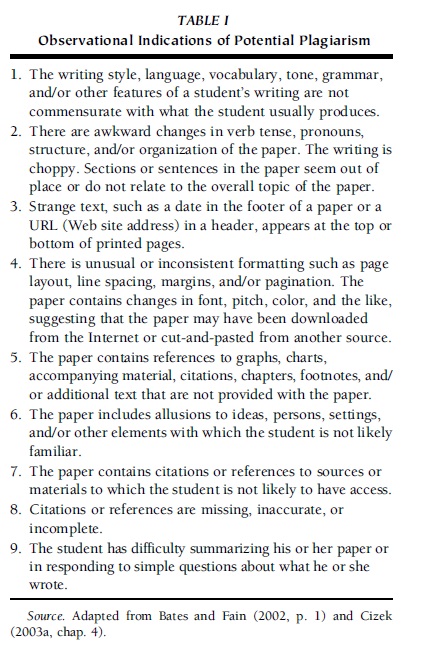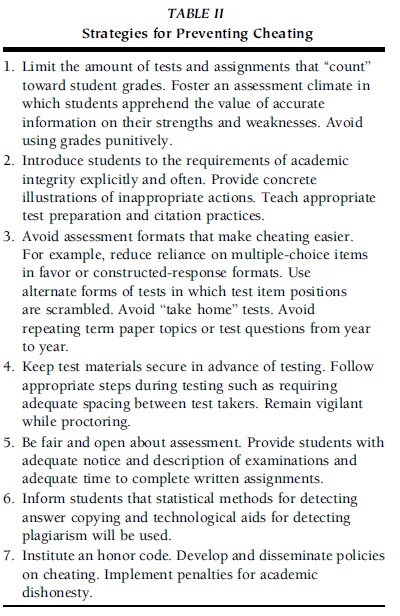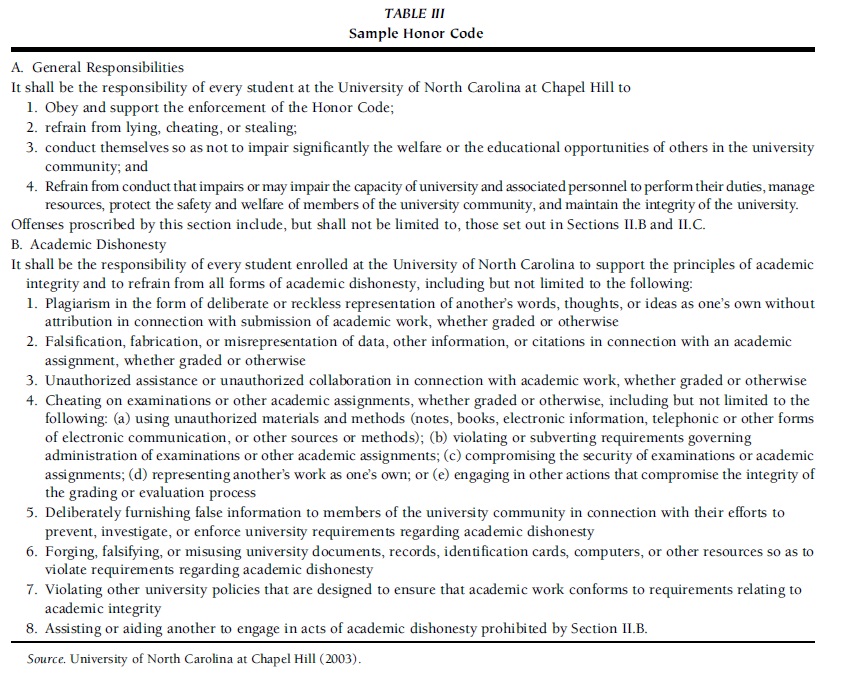This sample Cheating in Academics Research Paper is published for educational and informational purposes only. Free research papers are not written by our writers, they are contributed by users, so we are not responsible for the content of this free sample paper. If you want to buy a high quality research paper on any topic at affordable price please use custom research paper writing services.
Abstract
Cheating in academics refers to actions on the part of students that violate the explicit rules or commonly accepted norms for examinations or assignments. Cheating occurs at all levels, from the primary grades though testing for licensure or certification in a profession. Although most research on the topic of cheating has focused on inappropriate behavior on the part of those who take tests, cheating in academics can also include cheating by those who give tests. Reasonably accurate methods exist for detecting some types of cheating. Many strategies have also been proven to be effective for organizing instruction and assessment so that cheating can be prevented.
Outline
- Introduction
- Definitions and Examples
- Cheating and Validity
- Professional Guidelines on Cheating
- Detecting Cheating
- Preventing Cheating
1. Introduction
Sound assessment practice involves the development and administration of high-quality instruments and procedures to measure student learning. Assessment instruments can include graded tests and assignments. Information that results from these instruments can be helpful to students themselves or to others who use the information for educational decision making such as teachers, administrators, and policymakers. Increasingly in education contexts, consequences are also associated with performance on assessments. When the associated consequences are relatively serious, the assessment is said to involve high stakes.
The stakes associated with an assessment can be serious or mild, and they can be positive or negative. For example, awarding scholarship money to a student who performed at an exceptional level on a college admissions test would be considered a serious positive consequence. Assigning an elementary student to a remedial reading program due to a low test score could be either a positive or a negative consequence, depending on whether or not the remedial program was effective and other factors. Withholding a diploma because a student failed a graduation examination would be a fairly serious negative consequence. As the importance of decision making increases, and as the stakes associated with assessment rise, the problem of cheating becomes more pronounced.
Studies of cheating by students indicate that the incidence of the behavior increases as students pass through the grade levels, with the greatest frequency at the high school and college levels. Research evidence indicates that approximately 90% of students admit to having cheated on a test or an assignment, and it is estimated that 3 to 5% of students cheat on a given test or assignment.
2. Definitions And Examples
This research paper focuses on the kinds of cheating that occur in classroom situations. Cheating can occur on tests, for example, when one test taker copies test answers from another test taker. Cheating may also occur on assignments, such as on term papers or projects, when a student inappropriately uses material taken from another source for the assignment.
Regardless of the situation, a general definition of cheating can be developed. Cheating can be defined as any intentional action or behavior that violates the established rules governing the administration of a test or the completion of an assignment, gives one student an unfair advantage over other students on a test or an assignment, or decreases the accuracy of the intended inferences arising from a student’s performance on a test or an assignment.
Varieties of cheating by test takers can range from simple copying of another student’s answers to more elaborate schemes. An examinee may use unauthorized materials, such as a cheat sheet, or may take advantage of the testing situation by requesting testing accommodations that are not necessary. Cheating on assignments may involve impermissible books, notes, or persons when the use of such aids is contrary to guidelines provided for an out-of-class assignment. Academic cheating also may include plagiarism, in which the original words, thoughts, or ideas of another person are used without appropriate citation or referencing (usually for the purpose of intentionally misrepresenting such words, thoughts, or ideas as one’s own). Many Internet sources exist from which students can, either at no charge or for a fee, copy or download complete term papers or smaller portions of existing works. Finally, other forms of cheating exist in testing situations (e.g., when a person does not actually take a test himself or herself but rather relies on another person, called a confederate or surrogate, to do so) or on assignments when cheating may take the form of razoring (which involves the removal of material from a printed source document for the purpose of preventing others from gaining access to the source). More extensive lists of cheating methods were provided by Cizek in 1999 and 2003.
3. Cheating And Validity
Validity is the single greatest concern in any assessment situation. The concept refers to the accuracy of the interpretations about examinees based on their performance on a test or an assignment. In technical terms, validity is the degree to which evidence supports the inferences made about a person’s knowledge, skill, or ability based on his or her observed performance. By definition, inferences are based on a less than ideal amount of information such as a sample of a student’s knowledge or skill obtained via a test or term paper. Because it is often too costly or impractical to gather more information, inferences must be based on samples of behavior. Consequently, it is necessary to consider the accuracy of inferences based on the available evidence (e.g., test performance), that is, to consider validity. Any factor that attenuates the ability to make accurate inferences from the sample of performance threatens validity and jeopardizes the meaningfulness of conclusions based on the sample at hand. When cheating occurs, inaccurate inferences result.
4. Professional Guidelines On Cheating
Many educational institutions have developed honor codes to formalize expectations about academic integrity; to clearly define the types of actions that constitute cheating on tests, assignments, or other academic work; and to outline penalties for cheating. Test publishers usually produce carefully scripted directions for administering their tests and provide clear guidelines for what kind of behavior is permissible and what kind is not. Acceptable behavior and unacceptable behavior are also sometimes codified in states’ administrative regulations or statutes. Assessment specialists, through their professional associations, have developed professional guidelines to inform test takers and test administrators regarding inappropriate practices. The most authoritative of these guidelines are found in the Standards for Educational and Psychological Testing, a document that focuses on testing. Among their provisions, the standards indicate that those involved in testing programs should
- protect the security of tests (Standard 11.7);
- inform examinees that it is inappropriate for them to have someone else take the test for them, disclose secure test materials, or engage in any other form of cheating (Standard 8.7);
- ensure that individuals who administer and score tests are proficient in administration procedures and understand the importance of adhering to directions provided by the test developer (Standard 13.10);
- ensure that test preparation activities and materials provided to students will not adversely affect the validity of test score inferences (Standard 13.11);
- and maintain the integrity of test results by eliminating practices designed to raise test scores without improving students’ real knowledge, skills, or abilities in the area tested (Standard 15.9).
5. Detecting Cheating
Attempts to detect cheating can be performed by observational/judgmental or statistical methods. Observational/ Judgmental methods have the potential to detect cheating on academic assignments and tests. Statistical methods have been developed to detect a particular type of cheating (copying) on tests.
Observational/Judgmental methods rely more heavily on subjective human perceptions. For example, a student might enlist the aid of a surrogate to take an examination in his or her place. Human judgment is involved in detecting this form of cheating; exam proctors must be alert for test takers who do not appear familiar to them, must scrutinize examinees’ identifications prior to the test, and so on. Judgment is also involved when handwriting samples from the student are compared with those of the surrogate to make a determination of whose handwriting appears on the test materials or when a student obtains an unusually large score gain from one test administration to another.
Judgment is also involved in the detecting of plagiarism on written assignments such as term papers. A number of techniques can be used to ascertain whether a student’s written work is original or may have been plagiarized. Table I lists some common observational/ judgmental methods for detecting this form of cheating. In addition to observational/judgmental methods, statistical methods and computer technology can be invoked to aid in the detection of cheating.
Basic search engines (e.g., Google, Yahoo) can be used to locate Internet sources from which plagiarized material may have been drawn. This method relies on an instructor entering a unique word (or, better yet, a unique phrase or string of words) from a student’s paper to identify Internet sources containing the same string. Commercial (i.e., fee-based) Web sites devoted to the detection of plagiarism also exist. Most such sites require student work to be submitted electronically. Then, students’ papers are compared with those in databases of student work maintained by the host of the site. An overall probability is produced for each student’s work, indicating the overall degree of similarity between the student’s paper and all of the other sources. Software for local use that essentially performs a similar function of searching for common phrasings can also be purchased.
 TABLE I Observational Indications of Potential Plagiarism
TABLE I Observational Indications of Potential Plagiarism
Statistical methods are also available to gauge the probability of copying on multiple-choice tests. Information on these methods, including details regarding how to compute statistical indexes of cheating, was provided by Cizek in 1999 and by Sotaridona in 2003.
6. Preventing Cheating
 Many strategies exist for deterring cheating in academics. Many of these strategies are unique to the particular type of cheating to be deterred (i.e., whether on a test or on a written assignment). Other strategies aim to foster higher levels of academic integrity in general. Table II provides a list of specific ways in which to prevent cheating on tests and written assignments.
Many strategies exist for deterring cheating in academics. Many of these strategies are unique to the particular type of cheating to be deterred (i.e., whether on a test or on a written assignment). Other strategies aim to foster higher levels of academic integrity in general. Table II provides a list of specific ways in which to prevent cheating on tests and written assignments.
In addition, at the college and university levels, many institutions have found that inappropriate behavior can be prevented by developing and disseminating explicit expectations about academic integrity. Such expectations, formalized in what are referred to as honor codes, help to promote a campus culture and community characterized by the valuing of ethical conduct. An excerpt of one such honor code is reproduced in Table III. The excerpt shown is limited to the portion of the code related to cheating, and a source reference is provided for accessing the full code. TABLE II Strategies for Preventing Cheating
 TABLE III Sample Honor Code
TABLE III Sample Honor Code
References:
- American Educational Research Association, American Psychological Association, & National Council on Measurement in Education. (1999). Standards for educational and psychological testing. Washington, DC: Author.
- Bates, P., & Fain, M. (2002). Detecting plagiarized papers. www.coastal.edu.
- Cizek, G. J. (1999). Cheating on tests: How to do it, detect it, and prevent it. Mahwah, NJ: Lawrence Erlbaum.
- Cizek, G. J. (2003a). Detecting and preventing classroom cheating: Promoting integrity in schools. Thousand Oaks, CA: Corwin.
- Cizek, G. J. (2003b). Educational testing integrity. In J. E. Wall, & G. R. Walz (Eds.), Measuring up: Assessment issues for teachers, counselors, and administrators (pp. 363–386). Greensboro, NC: ERIC Counseling and Student Services Clearinghouse.
- Sotaridona, L. S. (2003). Statistical methods for the detection of answer copying on achievement tests. Enschede, Netherlands: Twente University Press.
- University of North Carolina at Chapel Hill. (2003). Instrument of student judicial governance. Chapel Hill, NC: Author. (Available: http://instrument.unc.edu)
See also:
Free research papers are not written to satisfy your specific instructions. You can use our professional writing services to order a custom research paper on any topic and get your high quality paper at affordable price.





